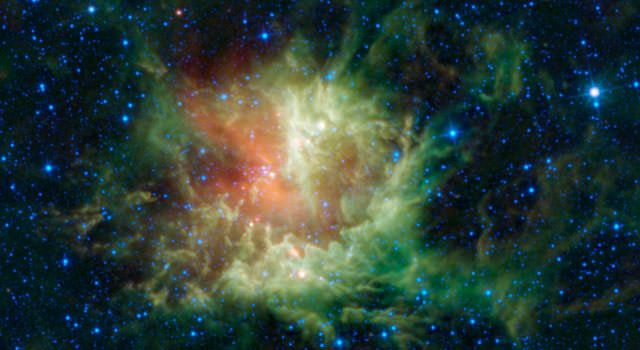[/caption]
If you have a large telescope and an appetite for nebulae, then you’ve probably seen the Pac Man Nebula. Located 9,200 light years away in the constellation Cassiopeia, NGC 281 (RA 00 52 59.3 – Dec +56 37 19) is a seasonal favorite… and in this new image it’s showing a real “Halloween” face!
Discovered in August 1883 by E. E. Barnard, this diffuse HII region is home to open cluster IC 1590, the multiple star HD 5005, and several Bok globules. To the eye of the amateur telescope, it’s a soft, round region with a distinctive notch that makes it resemble the PacMan of video game fame. However, when seen in infrared light by NASA’s Wide-field Infrared Survey Explorer, or WISE, the PacMan appears to have “teeth”!
Of course, astronomers know these fanciful fangs are actually pillars where new stars are forming. They are created when stellar winds and radiation from the accompanying cluster blow away the gas and dust, revealing the dense star dough. If you see small red sprinkles in this cosmic cookie, then you’re looking at what could be very young stars in the process of springing to life.
According to JPL News, this image was made from observations by all four infrared detectors aboard WISE. Blue and cyan (blue-green) represent infrared light at wavelengths of 3.4 and 4.6 microns, respectively, which is primarily from stars, the hottest objects pictured. Green and red represent light at 12 and 22 microns, respectively, which is primarily from warm dust (with the green dust being warmer than the red dust).
It’s a great trick… or “treat”!
Original Story Source: JPL News.


Nice Neb….On a good night you can easily see how it got it’s name.
Yo Tammy, Pacman also bit off the letter I at the beginning of the image caption.
“n visible light, the star-forming cloud catalogued as NGC 281 in the constellation of Cassiopeia appears to be chomping through the cosmos, earning it the nickname the “Pacman” nebula…”
Why oh why doesn’t JPL include a visible-light image of this nebula to easily relate to the public the reason for its’ nickname. For those unfamiliar with the view in visible light:
http://www.cosmosportal.org/files/36701_36800/36763/file_36763.jpg
http://www.cosmosportal.org/files/36701_36800/36764/file_36764.jpg